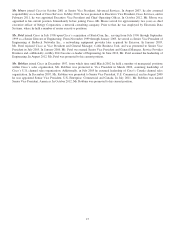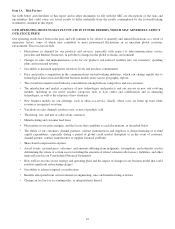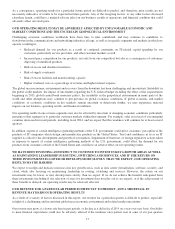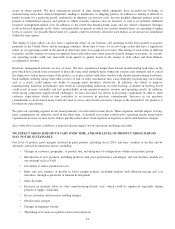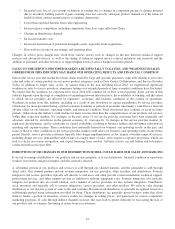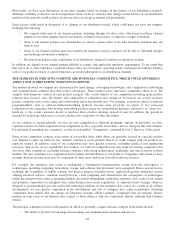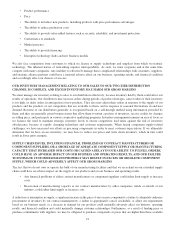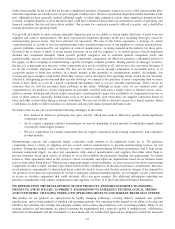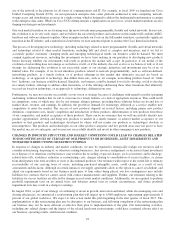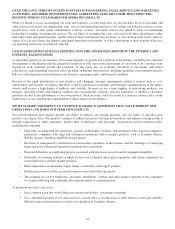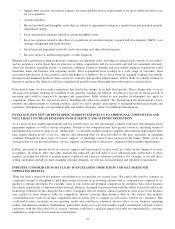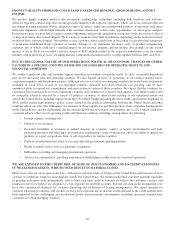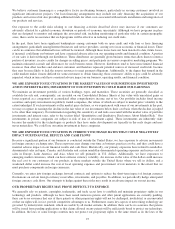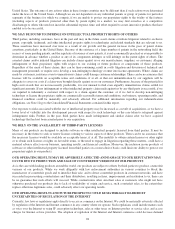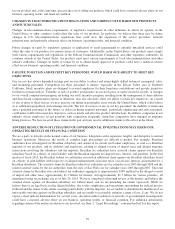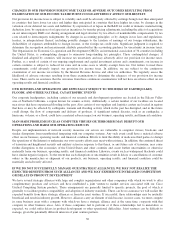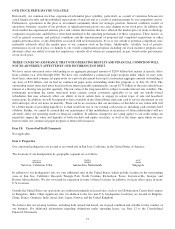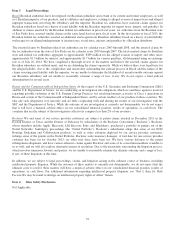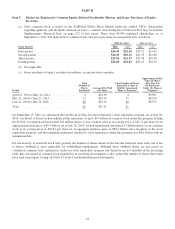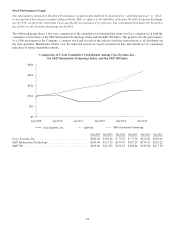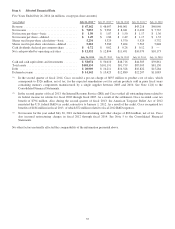Cisco 2014 Annual Report Download - page 33
Download and view the complete annual report
Please find page 33 of the 2014 Cisco annual report below. You can navigate through the pages in the report by either clicking on the pages listed below, or by using the keyword search tool below to find specific information within the annual report.• Significantly increase our interest expense, leverage and debt service requirements if we incur additional debt to pay
for an acquisition
• Assume liabilities
• Record goodwill and intangible assets that are subject to impairment testing on a regular basis and potential periodic
impairment charges
• Incur amortization expenses related to certain intangible assets
• Incur tax expenses related to the effect of acquisitions on our intercompany research and development (“R&D”) cost
sharing arrangement and legal structure
• Incur large and immediate write-offs and restructuring and other related expenses
• Become subject to intellectual property or other litigation
Mergers and acquisitions of high-technology companies are inherently risky and subject to many factors outside of our control,
and no assurance can be given that our previous or future acquisitions will be successful and will not materially adversely
affect our business, operating results, or financial condition. Failure to manage and successfully integrate acquisitions could
materially harm our business and operating results. Prior acquisitions have resulted in a wide range of outcomes, from
successful introduction of new products and technologies to a failure to do so. Even when an acquired company has already
developed and marketed products, there can be no assurance that product enhancements will be made in a timely fashion or
that pre-acquisition due diligence will have identified all possible issues that might arise with respect to such products.
From time to time, we have made acquisitions that resulted in charges in an individual quarter. These charges may occur in
any particular quarter, resulting in variability in our quarterly earnings. In addition, our effective tax rate for future periods is
uncertain and could be impacted by mergers and acquisitions. Risks related to new product development also apply to
acquisitions. Please see the risk factors above, including the risk factor entitled “We depend upon the development of new
products and enhancements to existing products, and if we fail to predict and respond to emerging technological trends and
customers’ changing needs, our operating results and market share may suffer” for additional information.
ENTRANCE INTO NEW OR DEVELOPING MARKETS EXPOSES US TO ADDITIONAL COMPETITION AND
WILL LIKELY INCREASE DEMANDS ON OUR SERVICE AND SUPPORT OPERATIONS
As we focus on new market opportunities and key growth areas, we will increasingly compete with large telecommunications
equipment suppliers as well as startup companies. Several of our competitors may have greater resources, including technical
and engineering resources, than we do. Additionally, as customers in these markets complete infrastructure deployments, they
may require greater levels of service, support, and financing than we have provided in the past, especially in emerging
countries. Demand for these types of service, support, or financing contracts may increase in the future. There can be no
assurance that we can provide products, service, support, and financing to effectively compete for these market opportunities.
Further, provision of greater levels of services, support and financing by us may result in a delay in the timing of revenue
recognition. In addition, entry into other markets has subjected and will subject us to additional risks, particularly to those
markets, including the effects of general market conditions and reduced consumer confidence. For example, as we add direct
selling capabilities globally to meet changing customer demands, we will face increased legal and regulatory requirements.
INDUSTRY CONSOLIDATION MAY LEAD TO INCREASED COMPETITION AND MAY HARM OUR
OPERATING RESULTS
There has been a trend toward industry consolidation in our markets for several years. We expect this trend to continue as
companies attempt to strengthen or hold their market positions in an evolving industry and as companies are acquired or are
unable to continue operations. For example, some of our current and potential competitors for enterprise data center business
have made acquisitions, or announced new strategic alliances, designed to position them with the ability to provide end-to-end
technology solutions for the enterprise data center. Companies that are strategic alliance partners in some areas of our business
may acquire or form alliances with our competitors, thereby reducing their business with us. We believe that industry
consolidation may result in stronger competitors that are better able to compete as sole-source vendors for customers. This
could lead to more variability in our operating results and could have a material adverse effect on our business, operating
results, and financial condition. Furthermore, particularly in the service provider market, rapid consolidation will lead to fewer
customers, with the effect that loss of a major customer could have a material impact on results not anticipated in a customer
marketplace composed of more numerous participants.
25


